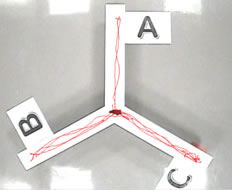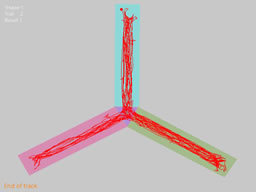Y maze
The Y maze can be used to investigate the spontaneous alternation and spatial working memory. The Y maze apparatus is consisted of three radial arms (60 cm long, 10 cm high and 10 cm wide) positioned at equal angle (120°). When animals are allowed to freely move between three arms, they are willing to explore new arms on successive opportunities. For this spontaneous alternation behavior, animals have to use their working memory to remember which arm they had entered on a previous occasion to enable them to alternate their choices on a following trial.
At the beginning of trials, a mouse is placed at the center area and allowed to move freely through the maze for 8-min. Arm entry is defined as having all four limbs inside an arm and the sequence of arm entries and duration in each arm is recorded and processed by the EthoVision XT. Spontaneous alternation behavior is defined as the entry into all three arms on consecutive choices in overlapping triple sets.
The percent spontaneous alternation behavior is:
{the actual alternations/ (total entries -2)} * 100.
|
|


